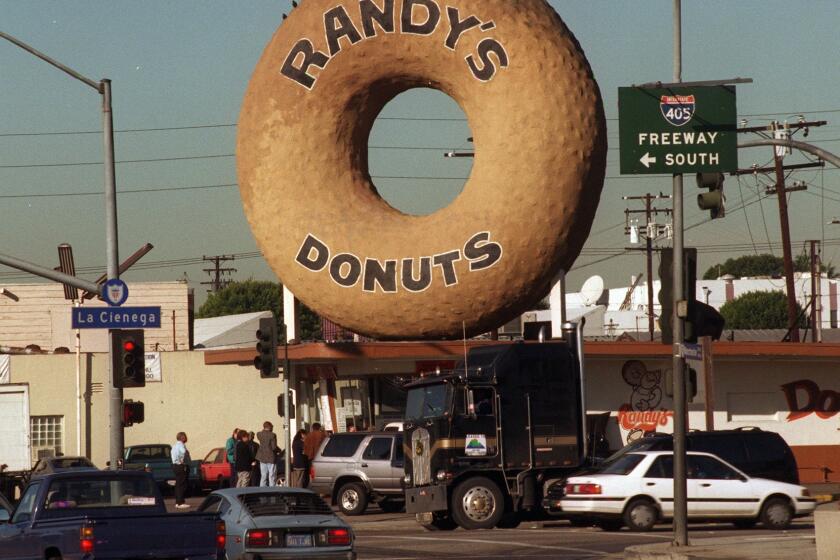Petitioners hope to dim plans for LED billboards at Costa Mesa’s Triangle Square
A plan to install 2,600-square-feet of LED billboards at Costa Mesa’s Triangle Square — part of a bid to attract new tenants and boost revenue at the struggling shopping center — is scheduled to go before the Planning Commission in November.
But some residents on the city’s east side are petitioning against the project and say they plan to oppose installations they believe will do the city more harm than good.
Tyler Mateen, who purchased the property in 2017, is seeking a 30-year development agreement that would sanction nearly 1,800 square feet of new signage as part of a planned signing program. The agreement would supersede a city ordinance prohibiting electronic signs with changing copy and those containing flashing, moving or intermittent lighting.
In a virtual community meeting Wednesday, Mateen and a handful of lighting, policy and design experts explained the project to about 20 members of the public.
LED signs include a 1,200-square-foot wraparound display on the dome of the building, in addition to a 600-square-foot sign on one corner and an 890-square-foot wall wrap on the other.
Digital advertisements on the LED signs would help fund the renovation and maintenance of the 200,000-square-foot property which, Mateen said, has historically struggled to maintain tenancy.
For the Costa Mesa shop, Randy’s owner Mark Kelegian envisioned a sign like the original roof-mounted dessert in Inglewood. But meeting the city’s sign laws proved a sticky situation.
He explained the center’s location between heavily trafficked 19th Street and Harbor and Newport boulevards complicates pedestrian access, which can ultimately lead to high retailer turnover. A consultant confirmed Thursday 12 of the 14 storefronts are occupied.
“When we acquired the center, shortly after we lost a few tenants and we had to give a bunch of tenants rent relief,” Mateen said, adding many tenants have managed to “stay alive” only through rent reduction. “It just wasn’t in a good place. So, we proposed this whole plan to revive the center and try to play up our strengths.”
In exchange for conferring the necessary development entitlements, the city would receive 25% of gross advertising revenue earned by the signs, an estimated $500,000 annually, starting in the third year and through the life of the agreement. A new owner would be obligated to carry out those terms.
The city would also govern aspects of the sign’s content and displays. As such, the signs will feature no animation, will not change images more than every 8 seconds and may not contain obscene or adult content pertaining to alcohol, tobacco, firearms, marijuana, payday loan or bail bond services, prescription medications or addiction treatment centers.
The billboards could be used to promote businesses within the center as well as outside businesses, also defined by the city in the agreement.
“This is a much higher level of restriction than any other billboards that are surrounding the area,” Coralee Newman, a governmental consultant hired by Mateen, said Wednesday.
Project consultants responded to resident concerns about the possibility of digitally lit signs distracting drivers, particularly those coming into town via the 55 Freeway.
“All of these signs can be dimmed, can be controlled and, frankly, are not as bright as the streetlights you’re very used to looking at,” said consultant Clifford Selbert of Selbert Perkins Design. “The ambient light in the neighborhood is actually much, much brighter.”
Architectural lighting designer Alex Stepniewski described a “nit,” an amount of perceived light equivalent to one candle’s illumination. At night, the LED billboards would be around 350 nits. By comparison, car headlights range from 3,500 to 8,500 nits, while a streetlamp’s light is 11,000 nits.
Longtime Costa Mesa resident Katie Arthur is one of more than 500 neighbors who have signed a petition against the plan. Eastside neighbors fought a similar-but-smaller LED sign proposal proposed by an erstwhile Triangle Square owner a decade ago and won.
Arthur said Thursday she wasn’t impressed with Mateen’s presentation and didn’t see how digital ads, especially for outside businesses, would improve tenants’ retail prospects.
“They have to prove to us that that would improve tenant occupancy and tenant revenue,” she said.
She cited light pollution and the area’s propensity for accidents among her chief concerns but said she was also worried that, when asked how much a digital ad would cost, Mateen and his consultants said they didn’t know.
“If you can’t tell us how much it would cost, how can you possibly estimate the revenue that would be coming into the city?” she said. “We’re going to fight this tooth and nail — there’s no way the neighborhood is going to go along with this peacefully.”
All the latest on Orange County from Orange County.
Get our free TimesOC newsletter.
You may occasionally receive promotional content from the Daily Pilot.





